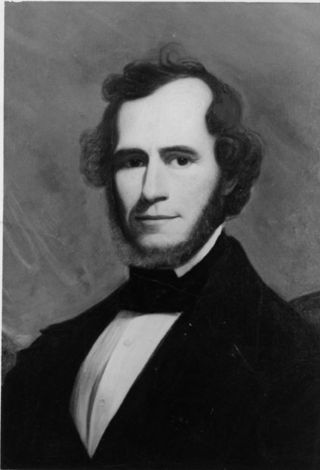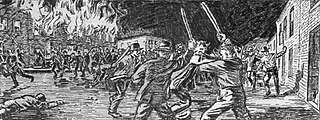In the broader context of racism against Black Americans and racism in the United States, mass racial violence in the United States consists of ethnic conflicts and race riots, along with such events as:

The 1856 United States presidential election was the 18th quadrennial presidential election, held on Tuesday, November 4, 1856. In a three-way election, Democrat James Buchanan defeated Republican nominee John C. Frémont and Know Nothing nominee Millard Fillmore. The main issue was the expansion of slavery as facilitated by the Kansas–Nebraska Act of 1854. Buchanan defeated President Franklin Pierce at the 1856 Democratic National Convention for the nomination. Pierce had become widely unpopular in the North because of his support for the pro-slavery faction in the ongoing civil war in territorial Kansas, and Buchanan, a former Secretary of State, had avoided the divisive debates over the Kansas–Nebraska Act by being in Europe as the Ambassador to the United Kingdom.

The Philadelphia nativist riots were a series of riots that took place on May 6—8 and July 6—7, 1844, in Philadelphia, Pennsylvania, United States and the adjacent districts of Kensington and Southwark. The riots were a result of rising anti-Catholic sentiment at the growing population of Irish Catholic immigrants. The government brought in over a thousand militia—they confronted the nativist mobs and killed and wounded hundreds of anti-Catholic rioters.

The Dead Rabbits was the name of an Irish American criminal street gang active in Lower Manhattan in the 1830s to 1850s. The Dead Rabbits were so named after a dead rabbit was thrown into the center of the room during a gang meeting, prompting some members to treat this as an omen, withdraw, and form an independent gang. Their battle symbol was a dead rabbit on a pike. They often clashed with Nativist political groups who viewed Irish Catholics as a threatening and criminal subculture. The Dead Rabbits were given the nicknames of "Mulberry Boys" and the "Mulberry Street Boys" by the New York City Police Department because they were known to have operated along Mulberry Street in the Five Points.

William Poole, also known as Bill the Butcher, was the leader of the Washington Street Gang, which later became known as the Bowery Boys gang. He was a local leader of the Know Nothing political movement in mid-19th-century New York City.

Thomas Swann was an American lawyer and politician who also was President of the Baltimore and Ohio Railroad as it completed track to Wheeling and gained access to the Ohio River Valley. Initially a Know-Nothing, and later a Democrat, Swann served as the 19th Mayor of Baltimore (1856–1860), later as the 33rd Governor of Maryland (1866–1869), and subsequently as U.S. Representative ("Congressman") from Maryland's 3rd congressional district and then 4th congressional district (1869–1879), representing the Baltimore area.

The Plug Uglies were an American Nativist criminal street gang, sometimes referred to loosely as a political club, that operated in the west side of Baltimore, Maryland, from 1854 to 1865. The term plug ugly was used to identify an extremely tough ferocious fighter who could give a sound beating to an opponent, with the Plug Uglies' name additionally stemming from their practice of stuffing oversized plug hats with wool and leather, pulling them down over their ears for head protection as primitive helmets during the numerous street battles they participated in. The name Plug Uglies was used to refer to a number of criminal gangs in New York City as well as Philadelphia.
Rip Raps is a small 15 acre artificial island at the mouth of the harbor area known as Hampton Roads in the independent city of Hampton in southeastern Virginia in the United States. Its name is derived from the Rip Rap Shoals in Hampton Roads, which also gave their name to a 19th-century criminal gang. In 2020 the island was converted into a bird sanctuary, and routine public access was terminated.

Thomas Watkins Ligon, a Democrat, was the 30th Governor of Maryland in the United States from 1854 to 1858. He was also a member of the United States House of Representatives, serving Maryland's third Congressional district from 1845 until 1849. He was the second Maryland governor born in Virginia and was a minority party governor, who faced bitter opposition from an openly hostile legislature.

Lewis Charles Levin was an American politician, newspaper editor and anti-Catholic social activist. He was one of the founders of the American Party in 1842 and served as a member of the U. S. House of Representatives representing Pennsylvania's 1st congressional district from 1845 to 1851. Levin was the first Jewish U.S. Congressman, although David Levy Yulee served as a territorial representative from Florida prior to Levin's election to the House.

Henry Joseph Gardner was the 23rd Governor of Massachusetts, serving from 1855 to 1858. Gardner, a Know Nothing, was elected governor as part of the sweeping victory of Know Nothing candidates in the Massachusetts elections of 1854.

The term Know-Nothing Riot has been used to refer to a number of political uprisings of the Nativist American Know Nothing Party in the United States of America during the mid-19th century. These anti-immigrant and anti-Catholic protests culminated into riots in Philadelphia in 1844, St. Louis in 1854, Cincinnati and Louisville in 1855, Baltimore in 1856, Washington, D.C., and New York in 1857, and New Orleans in 1858.

Bloody Monday was a series of riots on August 6, 1855, in Louisville, Kentucky, an election day, when Protestant mobs attacked Irish and German Catholic neighborhoods. These riots grew out of the bitter rivalry between the Democrats and the Nativist Know-Nothing Party. Multiple street fights raged, leaving twenty-two people dead, scores injured, and much property destroyed by fire. Five people were later indicted, but none were convicted, and the victims were not compensated.

The Know Nothing movement was a nativist political movement in the United States in the mid-1850s. The national political organization of the Know Nothings was officially known as the "Native American Party" prior to 1855; thereafter, it was simply known as the "American Party". Members of the movement were required to say "I know nothing" whenever they were asked about its specifics by outsiders, providing the group with its colloquial name.
Henry Stump (1795–1865) served as Judge of the Criminal Court, 5th Judicial Circuit in Baltimore, Maryland, United States, from 1851 to 1860, one of the most lawless and politically violent decades in Baltimore history. He presided over the infamous trial of Plug-Ugly Henry Gambrill for the murder of a Baltimore police officer. In 1860, the Maryland General Assembly removed Stump from office for "misbehavior," the only jurist in Maryland history to be removed from the bench. Stump was also an eyewitness to the April 19, 1861 riots in Baltimore that marked the first bloodshed in the American Civil War.

Samuel Hinks was Mayor of Baltimore, Maryland, from 1854 to 1856. He was a member of the Know Nothing party. He was succeeded in 1856 by fellow Know Nothing Thomas Swann.

The Cincinnati riot of 1853 was triggered by the visit of then-Archbishop Gaetano Bedini, the emissary of Pope Pius IX, to Cincinnati, Ohio, on 21 December 1853. The German Liberal population of the city, many of whom had come to America after the Revolutions of 1848, identified Cardinal Bedini with their reactionary opponents. An armed mob of about 500 German men with 100 women following marched on the home of Bishop John Purcell, protesting the visit. One protester was killed and more than 60 were arrested.

The Cincinnati Riots of 1855 were clashes between "nativists" and German-Americans. The nativists supported J. D. Taylor, the mayoral candidate for the anti-immigrant American Party, also known as the Know-Nothing Party. During the riots, German-Americans erected barricades in the streets leading into their Over-the-Rhine neighborhood, and fired a cannon over the heads of a mob of nativists attacking them.

In the 1855 Chicago mayoral election, Know Nothing candidate Levi Boone defeated Democratic incumbent Isaac Lawrence Milliken by a 5.75% margin.















